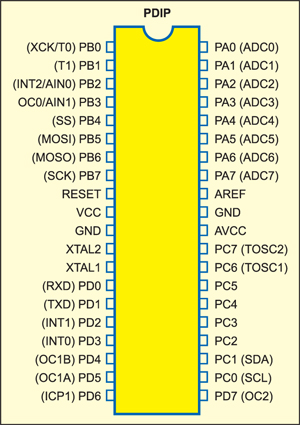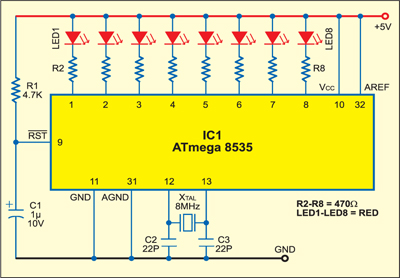The AVR 8535 microcontroller and its new version ATmega8535 are versatile, high-performance but low-cost chips. This article series covers typical applications of this processor illustrating its power and cost-effectiveness in an embedded system.
The AVR family comprises several chips, all with almost the same instruction set. Of them, the 90S8515, 90S8535 and ATmega8535 chips are low-cost and readily available with the complete set of port pins. The ATmega8535-16 is more powerful and available for around Rs 250. Capable of running at 16 MHz and achieving almost 16 million instructions per second (MIPS), it is one of the fastest devices available in the market today.


Using ATmega8535, you can build a microcontroller-based project with following features:
1. Four ports, of which one of them has eight analogue-to-digital converter (ADC) channels
2. ADC conversion time is as little as 60 microseconds. Imagine adding an external ADC to 8051 or any other microcontroller chip—that would have taken the cost to over four digits. And mind you, it is a 10-bit ADC, not just 8-bit.
3. If an 8MHz crystal is connected, each instruction executes in 1/8th of a microsecond. The 89C51 at 12MHz clock had its internal division by twelve, so it ran at just one microsecond.Thus, ATmega8535 chip is eight times faster with an 8MHz crystal. However, you can also use a higher-frequency crystal. The chip is basically a RISC processor that executes most instructions in one clock cycle itself.
4. The chip has RS-232 transmit and receive terminals much like the 8051 family, but it can support even higher baud rates.
5. It has quite a few internal registers, RAM, EEPROM and CODE memory (flash memory in excess of 4kB).
6. The instruction set is versatile, complete with several arithmetic, logic and transfer instructions and related jump instructions, etc.
7. An analogue comparator pin, which can compare an external analogue voltage and take control action.
8. Reset is possible through the software, and a watchdog is provided. Power-down or sleep modes are available.
9. An additional serial interface, known as the SPI bus, with three wires: data (2) and clock (1). These pins can be used for programming or loading the code from a PC through the printer port or serial port. For programming the internal flash memory locations, just 5V supply is enough.
10. Two PWM output pins, which are useful for power control applications.
11. Several timers as in other members of the 8051 family, but with much better time resolution.
12. Additional features like input capture and output compare.
Here, we shall delve into the chip’s operations with typical programs and circuits. All the development tools including ‘C’ compiler are available for free from the Internet.
The features of ATmega8535 make it the right candidate for various embedded control applications. Even a digital filter can be implemented on the device, provided you are fully conversant with its hardware and software features. You can download the databook of ATmega8535 from the ‘ATMEL.com’ Website to understand its features and work out simple applications.
The sample programs given here can be used to yield a powerful controller for many applications like a filter or motor controller.







Great Work!
This information help me a lot!